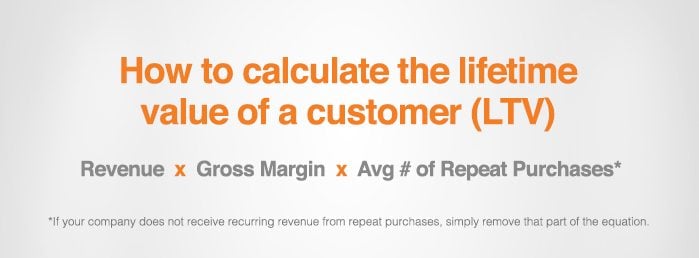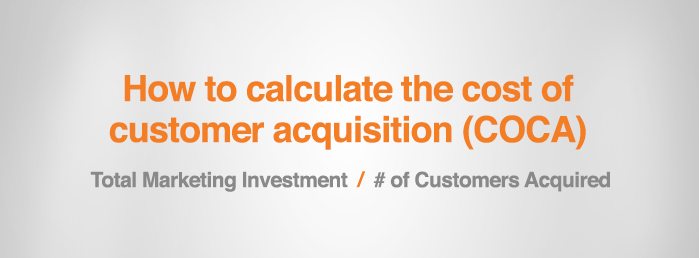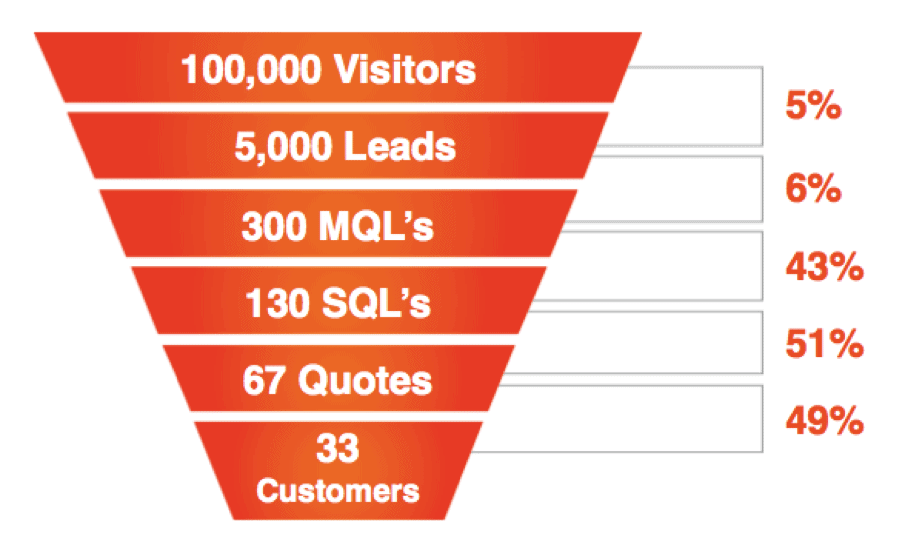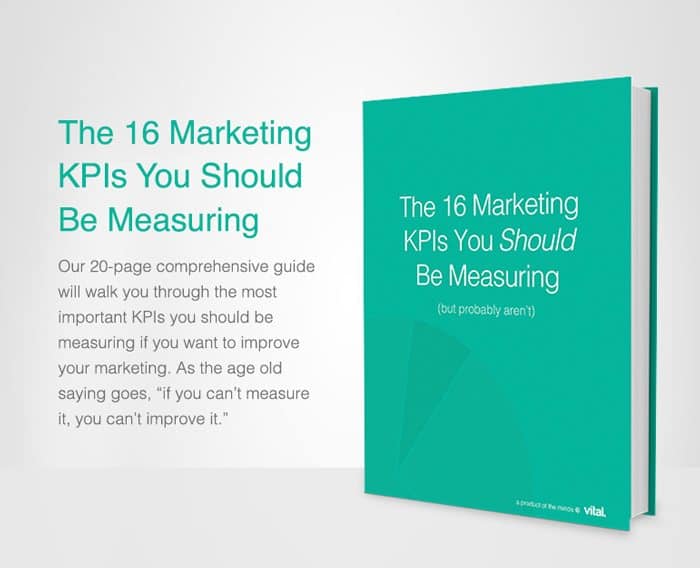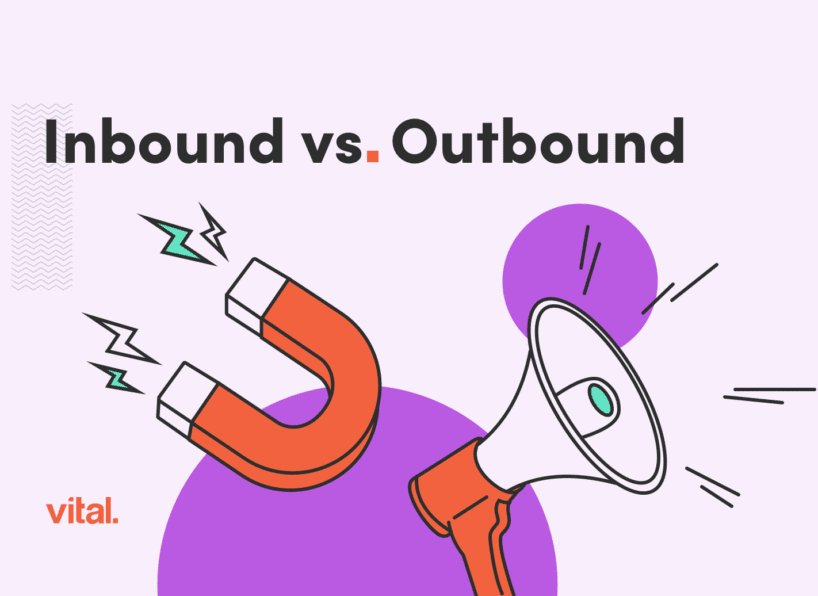Do you have any idea what makes your company’s marketing efforts successful? Any clue as to your business’ marketing performance? Any hint of why your company is doing well—or not so well?
Understanding what’s working and what’s not working in marketing—otherwise known as your marketing’s Key Performance Indicators (KPI)—should be an imperative part of your business’ growth strategy. If it’s not, well then you should probably keep reading.
As a business existing in the 21st century there should be no lack of understanding over what is making your company’s marketing efforts triumphant. And on the contrary, there should also be no mystery to what’s making your company’s marketing endeavors tank. All your marketing should be measurable. There is no excuse for not knowing why your company’s marketing efforts are killing it or getting killed by the competition. I repeat…there is NO EXCUSE for not knowing why your company’s marketing efforts are killing it or getting destroyed by the competition. Zero. Zilch. Nada. It’s time to start investing some time into understanding your company’s marketing KPIs. That time is now.
There are so many marketing KPI examples out there today—all of which likely have some applicability to your company’ marketing initiatives. Chances are if you conduct a simple search of ‘marketing KPIs’ you will find a mishmash of something or other that should help you improve your marketing strategy. But not all of them are helpful. For instance you won’t find any KPIs around old-school metrics like circulation, impressions or brand awareness on this list.
The following is a list of 16 helpful marketing KPIs you need to be measuring…but probably aren’t.
1. Sales Growth
At the end of the day the best way to judge your marketing’s success is by measuring its growth in sales revenue. Fair warning—to do this you must have a strong stomach. Once you start measuring your marketing’s effect on sales growth, it will initially take some adjusting to weed out the marketing that does drive sales. Measuring your sales growth is, however, vital to the long-term health of your company. Not only does it serve as a good indicator when it comes to strategic planning, but it also allows for identification of growth trends.
Don’t be shy in sharing your sales revenue with your employees as well. This often instills a level of ownership with your workforce and reinforces that everyone is in the same boat navigating toward the same end goals.
2. Leads
It’s simple math. The more leads you get the more sales opportunities you have and the more sales opportunities you have the better are your chances of sales growth. The importance of leads to a marketing and sales department is comparable to the importance of something like gasoline to an automobile—it’s what drives them.
Not all leads are created equal however. Be sure you’re familiar with the difference between Marketing Qualified Leads (MQLs) and Sales Qualified Leads (SQLs). These are simply different lifecycle stages of the same lead.
A marketing qualified lead (MQL) is a lead judged more likely to become a customer compared to other leads based on lead intelligence. MQLs are those people who have raised their hands (say by downloading an eBook or whitepaper) and identified themselves as more deeply engaged, sales-ready contacts than your usual leads, but who have not yet become fully fledged opportunities (source).
A sales qualified lead (SQL) is one that your sales team has accepted as worthy of a direct sales follow-up (source). SQLs have been vetted much further and indicate a prospect that is ready to make a decision.
Understanding the synergy between both MQLs and SQLs is vital toward understanding your company Leads to Close ratio—which is the number of leads you’ve received over a specific period of time divided by the actual amount of leads you’ve closed.
3. Lifetime Value of a Customer (LTV)
What is your customer worth to your business over the lifetime of your relationship? Any idea? Hello? Bueller?
The idea of determining just how much your customers are worth to you seems a bit daunting, however, that’s no excuse not to know it. This KPI is a great way to gauge your company’s ROI, and it’s a wonderful figure to help strategize future business goals. While not exact, figuring out the lifetime value of a customer involves figuring out all sales your average customer have initiated over the course of your relationship.
Need help calculating LTV? Let’s breakdown the key components: revenue and gross margin.
Revenue is the money a company receives during a particular financial period. Revenue is calculated by multiplying the price at which goods or services are sold by the number of units or amount sold. Total revenue or sales is not the same as profit.
Gross margin represents the percentage of total sales revenue that a company keeps as gross profit after deducting the costs directly related to producing the goods or services sold. You can calculate gross margin by subtracting the cost of goods sold from the total sales revenue and then dividing by the total net sales. For example, a company with a gross margin of 40 percent retains $0.40 for every dollar of revenue it receives. You can calculate gross margin not only for your whole company but also for each product line, which is where this figure is especially valuable.
Example:
Let’s say you’re a B2B company and you sell industrial equipment to other businesses. Let’s say your company sells an industrial strength dryer for $20,000. The revenue on the sale of the dryer is $20,000. However, your gross margin on that product is 35%. Now let’s assume this is a one time purchase and it’s not likely the customer will buy anything else from you ever again.
The lifetime value of this customer would be:
$20,000 (Revenue) x 35% (Gross Margin) = $7,000
However, in the scenario where repeat purchases are typical this calculation changes. Let’s say we’re in the situation outlined above, selling industrial-strength dryers for $20,000 a pop. Now let’s assume that in the customer’s lifetime they will buy on average five dryers.
The lifetime value of this customer would be:
$20,000 (Revenue) x 35% (Gross Margin) = $7,000 x 5 = $35,000.
4. Cost of Customer Acquisition (COCA)
The cost of customer acquisition is the cost associated in convincing a prospective customer to buy your company’s product or service. For example, let’s say you spent $200,000 on sales and marketing in a month and closed 20 new customers that month, then your COCA would be $10,000.
There’s always some nuance here, for example, if you pay a company to provide PPC management services, you need to include the click budget as well as the agency’s management fee. Once you have your COCA figured out, you can set goals for how many new customers you want to acquire in a year and then allocate your marketing budget appropriately.
5. Sales Team Response Time
In general, B2B leads receive staggeringly slow responses from sales teams. In fact, a lead response study of 2,241 US companies found that the average first response time of B2B companies to their leads was 42 hours!
This is a problem because the quality of a lead degrades over time. This research found “the odds of making a successful contact with a lead are 100 times greater when a contact attempt occurs within 5 minutes, compared to 30 minutes after the lead was submitted.
So the question is: How fast does your sales team respond to leads? And how fast does your competition’s sales team respond to leads? Once you’ve measured this KPI, you can then go about improving it. To learn more about the full effect of sales response time on lead close rate, check out this post.
6. Website Traffic to Website Lead Ratio
This is pretty straightforward. Of all your website visitors, how many of them convert and become leads? This KPI is helpful for measuring two things:
- The quality of your website’s traffic
- The conversion rate of your website
What is important here is to get a baseline, what is this ratio currently? And what can you do to improve it? Many times, focusing on improving the website’s conversion rate is an easy way to improve this ratio.
The following funnel graphic provides an overview for this KPI as well as the next several KPIs.
7. Website Lead to Marketing Qualified Lead (MQL) Ratio
Of all the website leads generated, how many get promoted to MQL status? This metric will help you understand the quality of the leads your marketing is generating. Do you have a low ratio where very few of your leads ever become marketing qualified? If so, you should probably look at the quality of your website traffic.
8. MQL to SQL Ratio
Of all your MQLs, how many get promoted to SQL status? This metric looks at the cooperation between the marketing team and the sales team. If there’s clear communication and understanding between these two teams, you can expect this ratio to be high. However, there is typically a disconnect between these teams leading to disagreement as to the quality of the leads marketing is generating or the attention they get once sales has them. It might be the case that marketing is generating a ton of leads but sales is not working them resulting in a low MQL to SQL ratio. You, of course, will not know any of this if you are not measuring this KPI.
9. SQL to Quote Ratio
This KPI is a direct reflection of the sales team’s ability to move qualified leads down the funnel to the quote/proposal stage. Why do some make it, and some don’t? There are a lot of factors that determine whether or not an SQL gets quoted (timeline, budget, competition, customization, etc.,), and it will be important to understand and study those factors in order to have better control over them.
10. Quoted to Closed Customer Ratio
Basically, this is your sales team’s close ratio. Of all the prospects your sales team quotes, how many end up closing and becoming a customer? Is this ratio higher or lower than last year? Why? What can you do to improve it?
11. Website Traffic
These are the people visiting your site. They are the potential leads that turn into potential customers. Why wouldn’t you want to know more about them?
Getting to know your website traffic is about finding out who these people are, where they’re from and what they did once they got to your site. All of this information can help you determine one all important piece of information: what it is they want from you. Knowing this helps you anticipate and anticipating your potential customers needs is what marketing is all about.
Website traffic is probably too generic of a term, however. The idea of website traffic consists of many things—all of which are highly measurable and heavily related to engagement. They include:
- Sessions
- Users
- Page views
- Page per Session
- Average Session Duration
- Bounce Rate
12. Social Media Reach and Engagement
Your social media strategy is a huge part of your inbound marketing efforts because it allows you to distribute your content and interact with your current and potential customers. But you already knew that didn’t you?
A good way to judge this KPI is to track your growth (think followers on Twitter and Likes on Facebook). Both social media sites have built in tracking and analysis that makes it incredibly easy to get this information when needed. You can also track engagement through metrics that determine lead conversions, customer conversions and percentage of web traffic associated with your social media efforts. And remember, not all social media will work for your business, so be sure to track the ones that really matter to you and your customer.
13. Email Marketing Performance
Your email marketing strategy is essentially your lifeline to your customer, aside from social media of course. As such, every email marketing campaign should be judged, analyzed, judged again and further analyzed.
Analyzing your email marketing strategy is multifaceted, however, and includes it’s own set of KPIs that should be dissected each on their own merits. Examples include:
- Delivery Rate
- Unsubscribe Rate
- Open Rate
- Click Through Rate
- Conversion Rate
- Forward/Shares
14. Inbound Link Building
Link building should be a cornerstone of your SEO strategy. When someone links to your website it means you’re building your street cred within your given industry. And the more people that link to your site as an authority, the better your search rankings and the more traffic your website will receive.
Not all inbound links are good links, however. You want quality links from other reputable industry sources. The name of the game here is followed linking root domains—you want links that Google actually follows (though there is also value in no-follow links). Need help measuring link acquisition and your site’s overall link profile? Try out Moz.
15. Landing Page Conversions
If the landing pages on your website are not drawing people in and converting them then you’re essentially dead in the water. A good way to judge whether or not your landing pages are working for you is to assess the amount of people who visit them and whether your CTAs are converting them.
Landing pages are constructed exclusively to guide website visitors into a conversion. But if the content on your landing page stinks, and is not properly SEO’d, then these people won’t end up sticking around and your conversion rate will suffer.
16. Blog Post Visits
Knowing the performance of your blog posts is a good way to gauge what your customers like to read and don’t like to read, as well as when they like to read. This, as a result, builds your brand equity and allows you an opportunity to further create your content around what your customers want and need.
Listen, your blog posts should be a major contributor to website traffic. We consider blog posts to be a traffic-driving tactic. This means that it should bring traffic to your website in two ways. The first is via distribution when it is published on social media platforms and when it is emailed out to your email list. The second is that it should rank in search engines for your target keywords.
And remember, while frequency of content is important, the length and overall quality of the content you’re putting on your blog is vitally important. A lot of companies have no problem starting a blog. Maintaining it is the hard part. Do your best to stay active with your content and your blog performance will prosper as a result.
Tracking your Marketing KPIs can help validate everything you do as a marketing professional—no matter if you work in the B2C or B2B world. And thanks to the countless tracking tools available today, businesses today have more opportunity for transparency in their marketing efforts than ever before. Get to know your marketing failures and fix them. Get to know your marketing successes and share them with your bosses.
If you need some help tracking your Marketing KPIs, we’re here for you. Give us a shout—even if you just have a simple question, send us a tweet or drop us a line. We provide digital marketing services, as well as WordPress design and development services. We’re always happy to answer questions.


